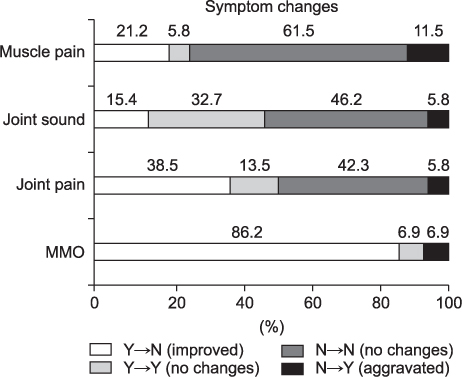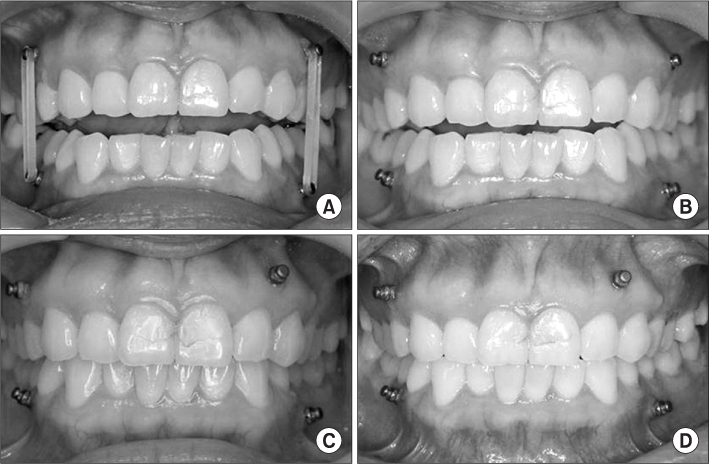J Korean Assoc Oral Maxillofac Surg.
2012 Oct;38(5):284-294. 10.5125/jkaoms.2012.38.5.284.
Anterior open bite with temporomandibular disorders treated with intermaxillary traction using skeletal anchorage system
- Affiliations
-
- 1Department of Oral and Maxillofacial Surgery, Gangnam Severance Hospital, College of Dentistry, Yonsei University, Seoul, Korea. omshuh@yuhs.ac
- KMID: 1434330
- DOI: http://doi.org/10.5125/jkaoms.2012.38.5.284
Abstract
OBJECTIVES
The anterior open bite with temporomandibular disorders (TMD) is one of the most challenging cases both orthodontically and surgically. We introduce an intermaxillary traction treatment for patients with anterior open bite and TMD using a skeletal anchorage system (SAS).
MATERIALS AND METHODS
This study was comprised of 52 patients with anterior open bite and TMD. A total of four mini-screws were inserted, two screws each into the maxilla and mandible, to obtain a class II pattern of elastic application with 120-200 g force. Adjunctive muscle relaxation treatments, such as splint therapy, medication, and botulinum toxin injection were applied during or before intermaxillary traction. At least one treatment among adjunctive muscle relaxation treatment, mentioned above, was applied to 96.2% of patients. We evaluated the clinical characteristics of patients, TMD symptom changes, amount of open bite improved. The degree of open bite improvement was compared between the open bite-reduced group (21 patients) and not-reduced group (5 patients).
RESULTS
TMD symptoms (muscle/joint pain, joint sound, mouth opening) remained or improved in most patients, and worsened in about 10% of patients for each items. Anterior open bite was improved by a mean of 1.75 mm (P<0.01) during treatment. The open bite-reduced group exhibited a significant open bite improvement compared to the not-reduced group (P<0.05), with 37% of open bite improvement occurring during the first 3 months of treatment.
CONCLUSION
The intermaxillary traction technique using SAS is a valid modality for correction of anterior open bite and improvement of TMD symptoms.
MeSH Terms
Figure
Cited by 1 articles
-
Conservative condylectomy alone for the correction of mandibular asymmetry caused by osteochondroma of the mandibular condyle: a report of five cases
Dong Sung Kim, Jae-Young Kim, Chan-Woo Jeong, Kwang-Ho Park, Jong-Ki Huh
J Korean Assoc Oral Maxillofac Surg. 2015;41(5):259-264. doi: 10.5125/jkaoms.2015.41.5.259.
Reference
-
1. Umemori M, Sugawara J, Mitani H, Nagasaka H, Kawamura H. Skeletal anchorage system for open-bite correction. Am J Orthod Dentofacial Orthop. 1999. 115:166–174.
Article2. Stansbury CD, Evans CA, Miloro M, BeGole EA, Morris DE. Stability of open bite correction with sagittal split osteotomy and closing rotation of the mandible. J Oral Maxillofac Surg. 2010. 68:149–159.
Article3. Denison TF, Kokich VG, Shapiro PA. Stability of maxillary surgery in openbite versus nonopenbite malocclusions. Angle Orthod. 1989. 59:5–10.4. Kuroda S, Sakai Y, Tamamura N, Deguchi T, Takano-Yamamoto T. Treatment of severe anterior open bite with skeletal anchorage in adults: comparison with orthognathic surgery outcomes. Am J Orthod Dentofacial Orthop. 2007. 132:599–605.
Article5. Kuroda S, Katayama A, Takano-Yamamoto T. Severe anterior open-bite case treated using titanium screw anchorage. Angle Orthod. 2004. 74:558–567.6. Williamson EH. Temporomandibular dysfunction in pretreatment adolescent patients. Am J Orthod. 1977. 72:429–433.
Article7. Riolo ML, Brandt D, TenHave TR. Associations between occlusal characteristics and signs and symptoms of TMJ dysfunction in children and young adults. Am J Orthod Dentofacial Orthop. 1987. 92:467–477.
Article8. Tanne K, Tanaka E, Sakuda M. Association between malocclusion and temporomandibular disorders in orthodontic patients before treatment. J Orofac Pain. 1993. 7:156–162.9. Wiberg B, Wänman A. Signs of osteoarthrosis of the temporomandibular joints in young patients: a clinical and radiographic study. Oral Surg Oral Med Oral Pathol Oral Radiol Endod. 1998. 86:158–164.
Article10. Smithpeter J, Covell D Jr. Relapse of anterior open bites treated with orthodontic appliances with and without orofacial myofunctional therapy. Am J Orthod Dentofacial Orthop. 2010. 137:605–614.
Article11. Arnett GW, Milam SB, Gottesman L. Progressive mandibular retrusion--idiopathic condylar resorption. Part I. Am J Orthod Dentofacial Orthop. 1996. 110:8–15.
Article12. Arnett GW, Milam SB, Gottesman L. Progressive mandibular retrusion-idiopathic condylar resorption. Part II. Am J Orthod Dentofacial Orthop. 1996. 110:117–127.
Article13. Mercuri LG. Laskin DM, Greene CS, Hylander WL, editors. Surgical management of TMJ arthritis. TMDs: an evidence-based approach to diagnosis and treatment. 2006. Chicago: Quintessence;455–468.14. Klasser GD, Greene CS. Oral appliances in the management of temporomandibular disorders. Oral Surg Oral Med Oral Pathol Oral Radiol Endod. 2009. 107:212–223.
Article15. Magdaleno F, Ginestal E. Side effects of stabilization occlusal splints: a report of three cases and literature review. Cranio. 2010. 28:128–135.
Article16. Fu AS, Mehta NR, Forgione AG, Al-Badawi EA, Zawawi KH. Maxillomandibular relationship in TMD patients before and after short-term flat plane bite plate therapy. Cranio. 2003. 21:172–179.
Article17. Arnett GW, Tamborello JA, Rathbone JA. Bell WH, editor. Temporomandibular joint ramifications of orthognathic surgery. Modern practice in orthognathic reconstructive surgery. 1992. Philadelphia: WB Saunders;523–594.18. Ellis E 3rd, Hinton RJ. Histologic examination of the temporomandibular joint after mandibular advancement with and without rigid fixation: an experimental investigation in adult Macaca mulatta. J Oral Maxillofac Surg. 1991. 49:1316–1327.
Article19. Hoppenreijs TJ, Stoelinga PJ, Grace KL, Robben CM. Long-term evaluation of patients with progressive condylar resorption following orthognathic surgery. Int J Oral Maxillofac Surg. 1999. 28:411–418.
Article20. Lopez-Gavito G, Wallen TR, Little RM, Joondeph DR. Anterior open-bite malocclusion: a longitudinal 10-year postretention evaluation of orthodontically treated patients. Am J Orthod. 1985. 87:175–186.
Article21. Lee HA, Park YC. Treatment and posttreatment changes following intrusion of maxillary posterior teeth with miniscrew implants for open bite correction. Korean J Orthod. 2008. 38:31–40.
Article22. Chang YI, Moon SC. Cephalometric evaluation of the anterior open bite treatment. Am J Orthod Dentofacial Orthop. 1999. 115:29–38.
Article23. Reitan K, Rygh P. Graber TM, Vanarsdall RL, editors. Biomechanical principles and reactions. Orthodontics: current principles and techniques. 1994. 2nd ed. St. Louis: Mosby;168–169.24. Proffit WR, Bailey LJ, Phillips C, Turvey TA. Long-term stability of surgical open-bite correction by Le Fort I osteotomy. Angle Orthod. 2000. 70:112–117.25. Oliveira JA, Bloomquist DS. The stability of the use of bilateral sagittal split osteotomy in the closure of anterior open bite. Int J Adult Orthodon Orthognath Surg. 1997. 12:101–108.26. Weinberg LA. Anterior condylar displacement: its diagnosis and treatment. J Prosthet Dent. 1975. 34:195–207.
Article27. Weinberg LA. Posterior bilateral condylar displacement: its diagnosis and treatment. J Prosthet Dent. 1976. 36:426–440.
Article28. Egermark I, Blomqvist JE, Cromvik U, Isaksson S. Temporomandibular dysfunction in patients treated with orthodontics in combination with orthognathic surgery. Eur J Orthod. 2000. 22:537–544.
Article29. Henrikson T, Ekberg EC, Nilner M. Symptoms and signs of temporomandibular disorders in girls with normal occlusion and Class II malocclusion. Acta Odontol Scand. 1997. 55:229–235.
Article30. Aghabeigi B, Hiranaka D, Keith DA, Kelly JP, Crean SJ. Effect of orthognathic surgery on the temporomandibular joint in patients with anterior open bite. Int J Adult Orthodon Orthognath Surg. 2001. 16:153–160.31. Kuroda S, Sugawara Y, Tamamura N, Takano-Yamamoto T. Anterior open bite with temporomandibular disorder treated with titanium screw anchorage: evaluation of morphological and functional improvement. Am J Orthod Dentofacial Orthop. 2007. 131:550–560.
Article32. Kaku M, Koseki H, Kawazoe A, Abedini S, Kojima S, Motokawa M, et al. Treatment of a case of skeletal class II malocclusion with temporomandibular joint disorder using miniscrew anchorage. Cranio. 2011. 29:155–163.
Article33. Seedorf H, Scholz A, Kirsch I, Fenske C, Jüde HD. Pivot appliancesis there a distractive effect on the temporomandibular joint? J Oral Rehabil. 2007. 34:34–40.
Article34. Cha YH, Kim BJ, Lim JH, Park KH, Kim HG, Huh JK. Analysis of treatment patterns of temporomandibular disorders. J Korean Assoc Oral Maxillofac Surg. 2010. 36:520–527.
Article35. Dionne RA. Laskin DM, Greene CS, Hylander WL, editors. Pharmacologic approaches. TMDs: an evidence-based approach to diagnosis and treatment. 2006. Chicago: Quintessence;347–357.36. De Laat A, Stappaerts K, Papy S. Counseling and physical therapy as treatment for myofascial pain of the masticatory system. J Orofac Pain. 2003. 17:42–49.37. Deshpande RG, Mhatre S. TMJ disorders and occlusal splint therapy: a review. International Journal of Dental Clinics. 2010. 2:22–29.
- Full Text Links
- Actions
-
Cited
- CITED
-
- Close
- Share
- Similar articles
-
- Anterior Open Bite with Temporomandibular Joint Osteoarthritis Treated with Skeletal Anchorage Device: A Case Report
- Use of Intermaxillary Traction Appliances and Exercises to Strengthen the Masticatory Muscles of Patients with Anterior Open Bite Caused by Temporomandibular Joint Osteoarthritis: Case Reports
- A study on the treatment of anterior open bite with midpalatal miniscrews
- Orthodontic Traction of the Permanent Molar Using Skeletal Anchorage: A Case Report
- A study of correlation on the skeletal factors of the anterior open bite






